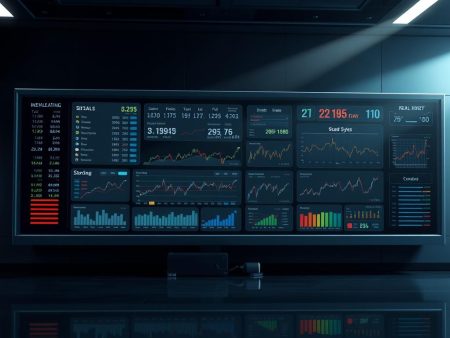Dive into our comprehensive analysis of XRP Exchange Traded Funds (ETFs). Uncover the benefits, challenges, and future outlook of XRP ETFs as we explore market volatility, regulatory concerns, and advancements in the crypto ETF landscape. Stay informed and prepare strategically for effective cryptocurrency investment strategies.
Unlocking XRP ETFs: Guide to Invest Wisely
You’ve likely heard the buzz about cryptocurrency and its potential for high-yield investment. But have you considered the role of Exchange Traded Funds (ETFs) in this landscape? Specifically, let’s delve into the world of XRP ETFs.
XRP, a digital asset and technology that facilitates faster, low-cost international transactions, is making waves in the crypto market. Coupling this with an ETF, a type of security that tracks an index, sector, commodity, or other asset, could be a game-changer.
In this article, we’ll explore the ins and outs of XRP ETFs, their potential benefits and risks. Whether you’re a seasoned investor or a curious beginner, this piece will shed light on a new frontier in digital investment. Buckle up, it’s time to embark on an enlightening journey through the world of XRP ETFs.
Understanding XRP ETFs
Understanding the dynamics of XRP ETFs isn’t just beneficial for a seasoned investor, it’s a must-know for beginners venturing into the sphere of digital investment.
What Is an ETF?
An Exchange Traded Fund (ETF) serves as a type of security that involves a collection of securities—such as stocks—that usually track an underlying index. In simpler terms, an ETF gives you a way to buy and sell a bucket of assets without having to buy all the components individually. The ETF shares are listed on a public stock exchange, with prices fluctuating throughout the trading day.
However, an ETF isn’t limited to stocks; it can comprise all types of investments such as bonds, commodities, or a mix of investment types. An ETF is marketable since it can be bought and sold like a normal company stock. Furthermore, similar to stocks, ETFs also possess ticker symbols and intraday price data can be easily obtained during the trading day.
How XRP ETFs Work
Incorporating digital currencies into an ETF structure, an XRP ETF tracks the value of Ripple’s XRP, a popular cryptocurrency. This means the performance of an XRP ETF mimics that of the XRP cryptocurrency.
If you choose to invest in XRP ETF, you’re investing in a fund that holds XRP as an underlying asset. The price dynamics of the ETF mirror the performance of XRP. Pertaining to this, investors acquire shares of the ETF that correspond to owning a specific quantity of XRP, but these shares are held by the fund, not the investors.
This setup provides an avenue for you to gain exposure to XRP without the risks and complexities of owning and storing the digital currency yourself. Hot wallets, cold storage, private keys—none of these will be part of your worry-list if you choose an XRP ETF over direct ownership.
However, like all investments, there are risks present. While you’re exempt from the intricacies of handling XRP, uncertainties tied to the crypto-market like sudden price drops aren’t eliminated. Be certain you understand these equations when you contemplate investing in XRP ETFs. Trading the XRP ETF, as opposed to holding actual XRP coins, could be an attractive alternative for those seeking investing in the crypto space with the benefits of the ETF structure.
Benefits of Investing in XRP ETFs
Subsequent to gaining an understanding of XRP ETFs in the preceding section, let’s delve deeper into their advantages to investors. A range of benefits accrue from investing in XRP ETFs, which include factors such as diversification, risk management, accessibility, and liquidity.
Diversification and Risk Management
A primary perk of investing in XRP ETFs lies in its potential for diversification. ETFs systematically bundle an array of assets, enabling investors to hold a stake in multiple crypto assets, inclusive of XRP, rather than investing in a singular entity or asset. Essentially, diversification reduces risk. For instance, if an investor has interests in five different types of crypto assets and one doesn’t perform well, the influence of the poorly performing asset is diluted because, in aggregate, the investor’s portfolio spans across five diverse holdings. Therefore, the investor mitigates their risk and bolsters their portfolio’s resistance to the erratic behaviour of a single asset.
Accessibility and Liquidity
Secondly, accessibility and liquidity pose as another advantage when considering XRP ETFs. As an investor, you’d find that trading XRP ETFs is akin to trading conventional securities. Transactions can happen directly on a stock exchange during market hours, and the buying or selling process is attractively straightforward and efficient. It’s particularly appealing to those who aren’t tech-savvy but wish to gain exposure to the crypto market. In terms of liquidity, XRP ETFs guarantee prompt conversions of assets into cash, a trait favored by investors seeking to improve the liquidity of their investment portfolios.
At its core, investing in XRP ETFs offers diversified exposure to the cryptocurrency market with risk management and liquidity benefits, striking a balance that entices both experts and novice traders. Despite these advantages, bear in mind the inherent volatility of the crypto market and duly conduct your research or consult an expert before investing.
Challenges and Risks of XRP ETFs
Investing in XRP ETFs, as with any sort of investment, carries a number of challenges and risks. Understanding these can help you make informed decisions.
Market Volatility
Cryptocurrencies, including XRP, exhibit significant market volatility, and XRP ETFs are not exempt from this trend. Proving the point, data from CoinMarketCap demonstrate this. On any given day, the price of XRP can surge or plunge without warning. Such unpredictability presents a substantial risk for investors, even those invested in XRP ETFs, which offer a level of diversification.
Despite these ETFs being rooted in a diversified selection of assets, XRP volatility can still significantly influence overall returns as any substantial changes in XRP’s market value can affect the XRP ETF. Also, consider how XRP’s volatility compares to assets like “trump coin crypto”, a wildcard in the crypto market, or other higher-risk coins highlighted for their volatility.
Regulatory Concerns
Regulatory concerns pose another significant challenge for XRP ETFs. Unlike traditional ETFs, those based on cryptocurrencies need to comply with complex and changing crypto regulations. XRP, the foundational asset for these ETFs, has been at the center of regulatory debates.
For instance, take the US Securities and Exchange Commission (SEC). It’s filed a lawsuit against Ripple Labs, alleging XRP is a security, not a cryptocurrency. If the case goes in the SEC’s favor, this could impact XRP ETFs’ legal status, potentially leading to delisting from securities exchanges. To illustrate, consider the challenges faced by “axitrader australia” or “axitrader singapore office”, dealing with different regulatory frameworks. Similarly, XRP ETFs have to navigate a dynamic and challenging regulatory landscape, making them a riskier investment.
Remember, investing smartly means staying aware of potential risks and challenges. Be it the unpredictability of the market or the flux of regulations, understanding different facets can help you make well-informed decisions when investing in XRP ETFs.
Future Outlook for XRP ETFs
The brewing arena of Exchange Traded Funds (ETFs) has witnessed noteworthy inclusions, one of them being XRP ETFs. Amid the ever-growing market of cryptocurrencies, knowledge about these investment tools plays a crucial part in your financial narrative. The future landscape of XRP ETFs is poised between advancements in crypto ETFs and the potential regulatory reforms.
Innovations in Crypto ETFs
Delve into the sphere of Crypto ETFs, you’ll notice a promising trend. Innovative strides have broadened the horizon for investors. These developments stem from addressing operational concerns to ensuring neat record-keeping. For instance, the advent of crypto custodian services enhances the security aspect, attracting investors into the crypto ETF landscape.
An XRP ETF, a specialized category under Crypto ETF basket, can offer the benefit of tracking the performance of XRP without actual possession of the digital asset. It essentially acts as a derivative of XRP and these ETFs may soon gain traction in the market, provided the regulatory environment becomes favorable.
In the rapidly evolving cryptocurrency market, even the mere speculation of an upcoming innovative product like an XRP ETF can cause substantial market movement. Therefore, as an investor, staying updated with these market developments plays a critical role in effective investment decision-making.
Potential Regulatory Changes
The path for XRP ETFs isn’t entirely smooth. Regulatory changes cast an imposing shadow on the future outlook. Financial regulators globally scrutinize cryptocurrency offerings, including XRP ETFs, mostly due to their disruptive potential coupled with security concerns.
The future of XRP ETFs relies heavily on the regulatory stance taken by influential financial institutions. For instance, the US Securities and Exchange Commission (SEC) considers the legal status for crypto ETFs, one that can guide XRP ETFs’ journey forward. In response to this uncertainty, the crypto market behaves with thoughtful progress, anticipating potential policy shifts.
Swift advancements in technology together with clearer regulatory framework could potentially pave the way to mass adoption and acceptance of XRP ETFs. Make an informed investment choice in XRP ETFs by keeping abreast with regulatory developments, and understand potential risks involved.
While the path is laced with regulatory hurdles, the alignment of innovative strides and clear legal frameworks might hold the key to a prosperous outlook for XRP ETFs. With the volatility of the crypto universe, strategic planning, knowledge updating, and risk understanding can form vital parts of your investment strategies.
Conclusion
You’ve navigated the ins and outs of XRP ETFs, understanding their potential benefits and inherent risks. It’s clear that despite market volatility and regulatory hurdles, there’s a promising future for this innovative investment tool. The ever-evolving crypto ETF landscape, combined with potential regulatory changes, could significantly impact the market. It’s crucial to stay abreast of these developments and adapt your strategies accordingly. Remember, the world of crypto is dynamic and requires a keen understanding of market trends and risk management. The future of XRP ETFs might be uncertain, but with careful planning and continuous learning, you can effectively navigate this volatile yet exciting investment terrain. Ultimately, the prosperity of XRP ETFs lies at the intersection of innovation, clear legal frameworks, and informed investment strategies.
What are the benefits of XRP Exchange Traded Funds (ETFs)?
XRP ETFs offer investors access to Ripple’s XRP with the added advantages of diversification and risk management. They provide liquidity and easy accessibility, making them a practical option in crypto investments.
What challenges and risks come with investing in XRP ETFs?
Investing in XRP ETFs comes with specific risks and challenges, including the inherent market volatility associated with cryptocurrencies. Regulatory concerns also pose potential issues, given the continuously evolving crypto landscape.
What is the future outlook for XRP ETFs?
The future outlook for XRP ETFs is generally positive, given advancements in the crypto ETF landscape. However, potential regulatory changes could significantly impact the market. Technological innovations combined with clear legal frameworks suggest a prosperous outlook for XRP ETFs.
How can an investor strategize effectively for investments in the volatile crypto market?
For effective investment strategies in the volatile crypto market, it is important to stay informed about market developments and potential regulatory shifts. Understanding the associated risks and navigating through them with continuous knowledge updating can lead to successful crypto investing.


